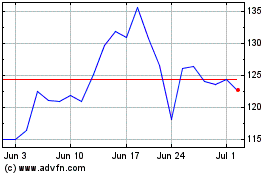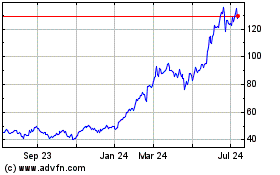NVIDIA today launched more than two dozen new microservices that
allow healthcare enterprises worldwide to take advantage of the
latest advances in generative AI from anywhere and on any cloud.
The new suite of NVIDIA healthcare microservices includes
optimized NVIDIA NIM™ AI models and workflows with
industry-standard APIs, or application programming interfaces, to
serve as building blocks for creating and deploying cloud-native
applications. They offer advanced imaging, natural language and
speech recognition, and digital biology generation, prediction and
simulation.
Additionally, NVIDIA accelerated software development kits and
tools, including Parabricks®, MONAI, NeMo™, Riva and Metropolis,
can now be accessed as NVIDIA CUDA-X™ microservices to accelerate
healthcare workflows for drug discovery, medical imaging and
genomics analysis.
The microservices, 25 of which launched today, can accelerate
transformation for healthcare companies as generative AI introduces
numerous opportunities for pharmaceutical companies, doctors and
hospitals. These include screening for trillions of drug compounds
to advance medicine, gathering better patient data to aid early
disease detection and implementing smarter digital assistants.
Researchers, developers and practitioners can use the
microservices to easily integrate AI into new and existing
applications and run them anywhere — from the cloud to on premises
— equipping them with copilot capabilities to enhance their
life-saving work.
“For the first time in history, we can represent the world of
biology and chemistry in a computer, making computer-aided drug
discovery possible,” said Kimberly Powell, vice president of
healthcare at NVIDIA. “By helping healthcare companies easily build
and manage AI solutions, we’re enabling them to harness the full
power and potential of generative AI.”
NVIDIA NIM Healthcare Microservices for
InferencingThe new suite of healthcare microservices
includes NVIDIA NIM, which provides optimized inference for a
growing collection of models across imaging, medtech, drug
discovery and digital health. These can be used for generative
biology and chemistry, and molecular prediction. NIM microservices
are available through the NVIDIA AI Enterprise 5.0 software
platform.
The microservices also include a collection of models for drug
discovery, including MolMIM for generative chemistry, ESMFold for
protein structure prediction and DiffDock to help researchers
understand how drug molecules will interact with targets. The VISTA
3D microservice accelerates the creation of 3D segmentation models.
The Universal DeepVariant microservice delivers over 50x speed
improvement for variant calling in genomic analysis workflows
compared to the vanilla DeepVariant implementation running on
CPU.
Cadence, a leading computational software company, is
integrating NVIDIA BioNeMo™ microservices for AI-guided molecular
discovery and lead optimization into its Orion® molecular design
platform, which is used for accelerating drug discovery.
Orion allows researchers at pharmaceutical companies to
generate, search and model data libraries with hundreds of billions
of compounds. BioNeMo microservices, such as the MolMIM generative
chemistry model and the AlphaFold-2 model for protein folding,
substantially augment Orion’s design capabilities.
“Our pharmaceutical and biotechnology customers require access
to accelerated resources for molecular simulation,” said Anthony
Nicholls, corporate vice president at Cadence. “By leveraging
BioNeMo microservices, researchers can generate molecules that are
optimized according to scientists’ specific needs.”
Nearly 50 application providers are using the healthcare
microservices, as are biotech and pharma companies and platforms,
including Amgen, Astellas, DNA Nexus, Iambic Therapeutics,
Recursion and Terray, and medical imaging software makers such as
V7.
"Generative AI is transforming drug discovery by allowing us to
build sophisticated models and seamlessly integrate AI into the
antibody design process,” said David M. Reese, executive vice
president and chief technology officer at Amgen. “Our team is
harnessing this technology to create the next generation of
medicines that will bring the most value to patients.”
Improving Patient and Clinician Interactions
Generative AI is changing the future of patient care. Hippocratic
AI is developing task-specific Generative AI Healthcare Agents,
powered by the company’s safety-focused LLM for healthcare,
connected to NVIDIA Avatar Cloud Engine microservices and will
utilize NVIDIA NIM for low-latency inferencing and speech
recognition.
These agents talk to patients on the phone to schedule
appointments, conduct pre-operative outreach, perform
post-discharge follow-ups and more.
“With generative AI, we have the opportunity to address some of
the most pressing needs of the healthcare industry. We can help
mitigate widespread staffing shortages and increase access to
high-quality care — all while improving outcomes for patients,”
said Munjal Shah, cofounder and CEO of Hippocratic AI. “NVIDIA’s
technology stack is critical to achieving the conversational speed
and fluidity necessary for patients to naturally build an emotional
connection with Hippocratic’s Generative AI Healthcare Agents.”
Abridge is building an AI-powered clinical conversation platform
that generates notes drafts, saving clinicians up to three hours a
day. Going from raw audio in noisy environments to draft
documentation requires many AI technologies to work together
seamlessly. Language identification, transcription, alignment and
diarization must all take place within seconds and conversations
must be structured according to the sorts of medical information
contained in each utterance, and powerful language models must be
applied to transform the relevant evidence into summaries. The
system turns clinical conversations into high-quality, after-visit
documentation in real time.
Flywheel creates models that can be transformed into
microservices. The company’s centralized, cloud-based platform
powers biopharma companies, life science organizations, healthcare
providers and academic medical centers, helping them identify,
curate and train medical imaging data to accelerate time to
insight.
“In this rapidly evolving landscape of healthcare technology,
the integration of NVIDIA’s generative AI microservices with
Flywheel’s platform represents a transformative leap forward,” said
Trent Norris, chief product officer at Flywheel. “By leveraging
these advanced tools, we are not only enhancing our capabilities in
medical imaging and data management but also driving unprecedented
acceleration in medical research and patient care outcomes.
Flywheel’s AI Factory powered by NVIDIA’s cutting-edge AI solutions
meets healthcare customers where they are, pushing the boundaries
of what’s possible in the realm of digital health and
biopharma.”
AvailabilityDevelopers can experiment with
NVIDIA AI microservices at ai.nvidia.com and deploy
production-grade NIM microservices through NVIDIA AI Enterprise 5.0
running on NVIDIA-Certified Systems™ from providers including Dell
Technologies, Hewlett Packard Enterprise, Lenovo and Supermicro,
leading public cloud platforms including Amazon Web Services (AWS),
Google Cloud, Microsoft Azure and Oracle Cloud Infrastructure, and
on NVIDIA DGX™ Cloud.
For more information, visit NVIDIA’s booth at GTC, running March
18-21 at the San Jose Convention Center and online, and watch the
replay of NVIDIA founder and CEO Jensen Huang’s keynote.
About NVIDIASince its founding in 1993, NVIDIA
(NASDAQ: NVDA) has been a pioneer in accelerated computing. The
company’s invention of the GPU in 1999 sparked the growth of the PC
gaming market, redefined computer graphics, ignited the era of
modern AI and is fueling industrial digitalization across markets.
NVIDIA is now a full-stack computing infrastructure company with
data-center-scale offerings that are reshaping industry. More
information at https://nvidianews.nvidia.com/.
For further information, contact:Janette
CiborowskiNVIDIA
Corporation+1-734-330-8817jciborowski@nvidia.com
Certain statements in this press release including, but not
limited to, statements as to: the benefits, impact, performance,
features, and availability of NVIDIA’s products and technologies,
including NVIDIA accelerated software development kits and tools
including Parabricks, MONAI, NeMo, Riva and Metropolis, NVIDIA AI
Enterprise 5.0 software platform, NVIDIA’s microservices, such as
NIM, CUDA-X, BioNeMo, Avatar Cloud Engine, VISTA 3D, Universal
DeepVariant, NVIDIA-Certified Systems; and NVIDIA DGX Cloud; our
ability to represent the world of biology and chemistry in a
computer, making computer-aided drug discovery possible; NVIDIA
enabling healthcare companies to harness the full power and
potential of generative AI by helping them easily build and manage
AI solutions; third parties’ use and adoption of our products and
technologies, and the benefits and impacts thereof; researchers
being able to generate molecules that are optimized according to
scientists’ specific needs by leveraging BioNeMo microservices;
generative AI allowing third parties to build sophisticated models
and seamlessly integrate AI into the antibody design process and to
create the next generation of medicines that will bring the most
value to patients; generative AI changing the future of patient
care; and third parties’ ability to mitigate widespread staffing
shortages and increase access to high-quality care while improving
outcomes for patients with generative AI are forward-looking
statements that are subject to risks and uncertainties that could
cause results to be materially different than expectations.
Important factors that could cause actual results to differ
materially include: global economic conditions; our reliance on
third parties to manufacture, assemble, package and test our
products; the impact of technological development and competition;
development of new products and technologies or enhancements to our
existing product and technologies; market acceptance of our
products or our partners' products; design, manufacturing or
software defects; changes in consumer preferences or demands;
changes in industry standards and interfaces; unexpected loss of
performance of our products or technologies when integrated into
systems; as well as other factors detailed from time to time in the
most recent reports NVIDIA files with the Securities and Exchange
Commission, or SEC, including, but not limited to, its annual
report on Form 10-K and quarterly reports on Form 10-Q. Copies of
reports filed with the SEC are posted on the company's website and
are available from NVIDIA without charge. These forward-looking
statements are not guarantees of future performance and speak only
as of the date hereof, and, except as required by law, NVIDIA
disclaims any obligation to update these forward-looking statements
to reflect future events or circumstances.
© 2024 NVIDIA Corporation. All rights reserved. NVIDIA, the
NVIDIA logo, BioNeMo, CUDA-X, DGX, NVIDIA-Certified Systems, NVIDIA
NeMo, NVIDIA NIM, and Parabricks are trademarks and/or registered
trademarks of NVIDIA Corporation in the U.S. and/or other
countries. Other company and product names may be trademarks of the
respective companies with which they are associated. Features,
pricing, availability, and specifications are subject to change
without notice.
A photo accompanying this announcement is available at
https://www.globenewswire.com/NewsRoom/AttachmentNg/6055d36c-5579-4a4f-83c7-367d308f1c36
NVIDIA (NASDAQ:NVDA)
Historical Stock Chart
From Mar 2024 to Apr 2024

NVIDIA (NASDAQ:NVDA)
Historical Stock Chart
From Apr 2023 to Apr 2024
